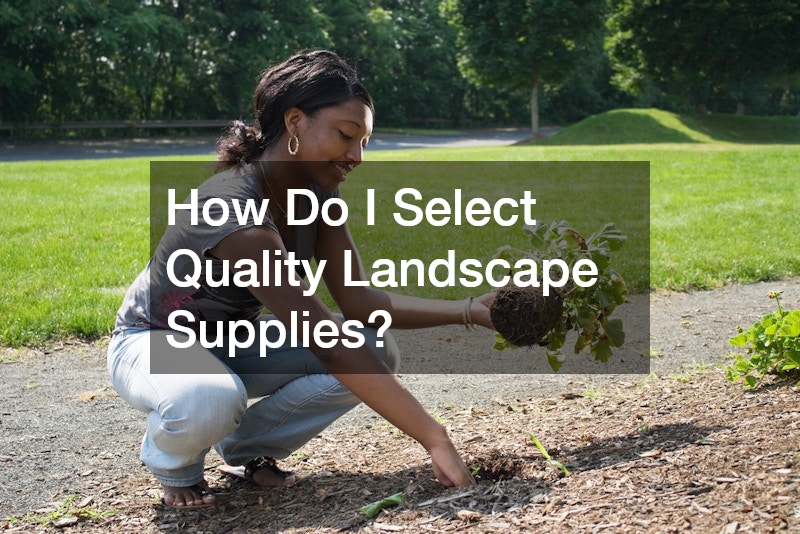When planning a landscaping project—whether you’re redesigning a backyard or creating a new outdoor space—selecting the right materials is just as crucial as the design itself. Quality landscape supplies are the foundation of a successful project, influencing not only the aesthetics but also the longevity and function of your garden, lawn or outdoor structure. The first step in selecting quality landscape supplies is to determine the scope and purpose of your project.
Are you installing a decorative garden bed, building a retaining wall or creating a functional outdoor living area? Each of these applications requires specific materials with distinct properties. For instance, soil for planting beds needs to be rich and well-draining, while the gravel used under paving stones should be compactable and structurally sound. Understanding the demands of your project allows you to choose supplies that meet performance requirements without compromising on appearance.
Choosing a Reputable Supplier
Supplier reputation is another key factor. A reliable supplier will stock products that are consistent in quality, ethically sourced and suited to Australian conditions. They should also offer expert advice tailored to your specific goals. Don’t hesitate to ask questions about the origin of materials, especially when it comes to items like mulch, soil and stone. Locally sourced products often perform better in your regional climate and may have a smaller environmental footprint. Additionally, visiting a landscape yard in person gives you a chance to inspect the supplies before purchasing. This hands-on approach helps assess the texture, colour and size of materials, ensuring they align with your project vision.
Durability & Sustainability
It’s important to consider the durability and sustainability of landscape supplies. Products that appear similar at a glance can vary greatly in quality. For example, not all mulches decompose at the same rate or provide equal weed suppression. Hardwood mulch, while sometimes more expensive, tends to last longer and adds structure to garden beds over time. In contrast, cheaper alternatives might break down too quickly or encourage pests.
Similarly, timber used for edging or retaining walls should be treated for resistance against rot and termites, especially in moist environments. These factors can significantly affect the lifespan of your landscaping, so choosing materials that withstand local conditions is vital.
Balancing Cost & Value
While price is a consideration, the cheapest option is rarely the most economical in the long term. Low-cost materials may lack the structural integrity or weather resistance needed to withstand Australia’s varied climate, leading to additional maintenance or premature replacement. Instead, focus on value—selecting products that offer durability, reliability and ease of installation. Ask your supplier about the expected lifespan of each material and whether they provide warranties or support for their products. Investing a bit more upfront can save considerable time and money down the track.
Design Consistency & Appearance
Design consistency also plays a role in the quality of your finished space. The appearance of your landscape supplies should complement one another and enhance your overall aesthetic. For example, if you are using sandstone pavers, choose matching or contrasting gravel and edging that harmonises with the warm tones of the stone. The uniformity in colour and texture contributes to a polished and professional look, even in a DIY setting. Paying attention to these details can significantly elevate the final result of your landscaping efforts.
Functionality & Practicality
Functionality should never be overlooked. Each material should serve a clear purpose while supporting the usability of the space. Whether it’s permeable pavers that aid drainage or compacted road base for supporting heavy foot traffic, every choice must align with the practical demands of the area. Speak to experienced landscapers or garden designers if you’re unsure—many are happy to provide consultations or referrals to trustworthy supply sources.
Transport, Handling & Logistics
Transport and handling are also worth considering. Some landscape supplies are heavy or bulky, making them difficult to manage without the right equipment. Check whether your supplier offers delivery options and if the materials will be dropped at a convenient location on your property. This can prevent damage during unloading and reduce labour, particularly for larger projects. If you’re picking up supplies yourself, make sure you have access to an appropriate vehicle and understand the safety requirements for loading and transporting materials.
Compliance & Environmental Responsibility
Lastly, ensure that your choice of landscape supplies complies with local regulations and environmental guidelines. For instance, certain types of sand or stone may not be suitable near water catchments or protected areas. Using eco-friendly materials and sustainable practices not only benefits the environment but may also add value to your property, as modern homebuyers are increasingly interested in green credentials and low-maintenance outdoor spaces.
Final Thoughts on Selecting Quality Landscape Supplies
Selecting quality landscape supplies involves a balance of research, observation and consultation. It’s about more than simply picking what looks good on the shelf—it’s about understanding how each material interacts with the environment and supports the integrity of your design. By making informed choices and partnering with reputable suppliers, you’ll be better positioned to bring your vision to life with materials that truly support it. Whether you’re tackling a small backyard revamp or a large-scale outdoor transformation, investing in the right landscape supplies from the start ensures a smoother process and a more satisfying result.
.




